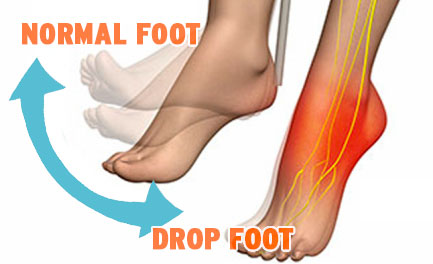Drop Foot Treatment at Spine and Laser Center
Drop Foot is a symptom associated with an underlying neurological, muscular or anatomical problem that can usually be treated with a combination of non-intrusive techniques.
Overview
 Drop foot (or foot drop) is a general term in which the lifting of the forefoot (front part of the foot) is difficult. Drop foot is not a diagnosis in and of itself; rather, it is a symptom associated with an underlying neurological, muscular or anatomical problem, including nerve or muscle injury or disorder or a brain/spinal cord disorder, including Herniated disc, Spinal Stenosis, Spondylolisthesis, and Vertebral Fractures. Walking is made difficult, so the foot might drag on the floor. Those suffering from drop foot may also attempt to compensate by raising the thigh up in an exaggerated fashion while walking, as if climbing the stairs. High steppage gait is the most common symptom of drop foot.
Drop foot (or foot drop) is a general term in which the lifting of the forefoot (front part of the foot) is difficult. Drop foot is not a diagnosis in and of itself; rather, it is a symptom associated with an underlying neurological, muscular or anatomical problem, including nerve or muscle injury or disorder or a brain/spinal cord disorder, including Herniated disc, Spinal Stenosis, Spondylolisthesis, and Vertebral Fractures. Walking is made difficult, so the foot might drag on the floor. Those suffering from drop foot may also attempt to compensate by raising the thigh up in an exaggerated fashion while walking, as if climbing the stairs. High steppage gait is the most common symptom of drop foot.
Treatment
Your Chiropractor is likely to use a combination of techniques to help your condition, but treatment is dependent on the cause.
Spinal adjustments focus on providing better spinal column alignment, which in turn is designed to help address a number of associated conditions. Other modalities may include acupuncture and Massage therapy. Custom orthotics or braces can provide additional support, stability, and shock absorption from the ground up.
Specific exercises may be advised to help the affected muscles. When drop foot has caused a significant gait (walk) disturbance, physical therapy may be necessary.
Prevention
Prevention techniques include keeping your bones and tissues strong and healthy through exercise and diet. Avoid tobacco and excessive alcohol use as these can weaken bones and cause problems with the blood supply in the extremities. Reduce your risk of injury by adhering to safety measures on the job and beyond (like wearing a seatbelt). Custom orthotics can provide additional support, stability, and shock absorption from the ground up.
Other risk factors include: frequent/prolonged periods of crossing the legs; this can compress the peroneal nerve on their uppermost leg. Prolonged kneeling, such as on the job (certain construction functions laying tile, farm work). Wearing a leg cast.
Recovery
Some cases of drop foot are temporary; others are permanent. The recovery time and process are dependent on the cause.
Symptoms of Drop Foot
- High steppage gait, characterized by raising the thigh up in an exaggerated fashion while walking, as if climbing the stairs
- Foot drop may be experienced in one or both feet. It is typically experienced in one foot if the drop foot is caused by a low back condition
- Foot and toes dragging
- Exaggerated hip swinging motion
- Limpness, tingling, numbness, and/or slight pain in the foot
- Muscle atrophy in the leg

